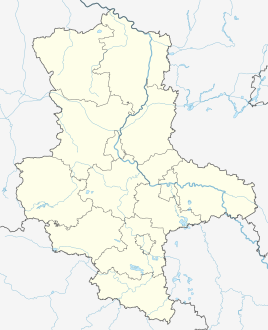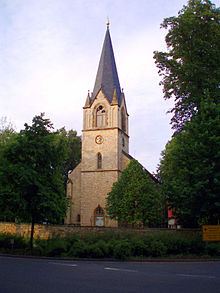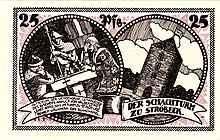Chess village Ströbeck
|
Chess village Ströbeck
City of Halberstadt
|
||
|---|---|---|
| Coordinates: 51 ° 55 ′ 0 ″ N , 10 ° 56 ′ 59 ″ E | ||
| Height : | 156 m above sea level NN | |
| Area : | 13.46 km² | |
| Residents : | 1157 (Dec. 31, 2008) | |
| Population density : | 86 inhabitants / km² | |
| Incorporation : | January 1, 2010 | |
| Postal code : | 38822 | |
| Area code : | 039427 | |
|
Location of Schachdorf Ströbeck in Saxony-Anhalt |
||
The chess village Ströbeck is a district of Halberstadt in the Harz district in Saxony-Anhalt . The place's chess tradition , which dates back to the Middle Ages, is a unique selling point that has been recognized as an intangible cultural heritage in Germany. The German UNESCO Commission therefore included Ströbeck in the nationwide register of intangible cultural heritage in December 2016 .
geography
Geographical location
The chess village Ströbeck is about eight kilometers west of Halberstadt's core city.
history
Ströbeck was first mentioned on October 20, 995 in a document from King Otto III. To equip his sister Adelheid, he donated the feudal estate to the canonical monastery in Quedlinburg , which his feudal husband Dietrich in the Harzgau in the county of Count Friedrich owned in five places (in villis Godenhusun, Sifrithusun, Vinchesdorp, Strebechi, Vuidermuodi) .
On August 1, 1004, Ströbeck was mentioned for the second time as Strebeki in a deed of donation from King Heinrich II to the Drübeck Abbey. As a fiefdom of the Halberstadt Monastery, Ströbeck was owned by the Counts of Regenstein , who had to cede the village to the Counts of Wernigerode in 1343 .
Since an army and later post road ran through the village since the Middle Ages, the predominantly agricultural town was not spared from looting in times of war. However, he was usually able to recover quickly, as wheat and sugar beet developed well on the fertile soils and usually ensured rich harvests. In recent times there has been an increase in craft businesses and an increase in tourism.
Ströbeck is best known for the game of chess , which characterizes the village and which is why the place has officially been called Schachdorf Ströbeck since 1991 . According to legend, in 1011 a noble prisoner of the Halberstadt bishop (allegedly Gunzelin von Kuckenburg ) taught the game to his guards there.
The first written mention of the game of chess in Ströbeck comes from 1515. The Ströbeck chess game is described in detail in the first German-language chess book Das Schach-Spiel or König-Spiel by Duke August von Braunschweig-Wolfenbüttel, alias Gustavus Selenus , published in Leipzig in 1616 . Since 1689, public performances of chess games have been documented, in which the chess pieces were represented by appropriately disguised people. This tradition is still continued today by the Ströbeck chess club founded in 1883 .
In 1913 HJ R Murray deals with Ströbeck and his way of playing chess in five chapters in his book "A History of Chess". In 1921 the community issued emergency money with chess motifs.
At the elementary school - today named after the world chess champion Emanuel Lasker - chess has been a compulsory subject since 1823.
At the beginning of the 1990s, the Ströbecker Schachfreunde formed a community of voters that received the most votes in local elections .
In 2006, the chess chronicle written by Friedrich Lucanus in 1756 was transcribed from the archive of the Ströbeck parish and can be viewed as a copy in the library of the chess museum . These are the first records of the origin of the chess tradition in Ströbeck.
On January 1, 2010, the previously independent community of Schachdorf Ströbeck was incorporated into the city of Halberstadt together with the communities of Athenstedt , Langenstein , Sargstedt and Aspenstedt .
Ströbeck and the chess village Ströpken (East Prussia)
The village Uschakowo , which is located today in the Osjorsk district ( Darkehmen district , 1938–1946 Angerapp ) in the Kaliningrad Oblast ( Königsberg region (Prussia) ) was called Ströpken until 1946. The similarity of the name to Ströbeck is not accidental: Villagers from Ströbeck settled in East Prussia, depopulated by the plague (1709–1711) at the beginning of the 18th century, and retained their enthusiasm for chess games. After a game of chess by the village mayor against King Friedrich Wilhelm I in 1729 , which the monarch lost, the former Ströbeckers received permission to rename the settlement previously known as “Mazaitschen” to “Ströbeck”. Adapted to the East Prussian dialect, the name Streepke was created , later Ströpken .
badges and flags
The coat of arms was awarded on November 27, 1937 by the Upper President of the Province of Saxony.
Blazon : "In red, a black and silver chessboard with 64 fields set over a corner."
A chess board is the old seal image of the chess village.
The coat of arms was designed by the Magdeburg State Archives Councilor Otto Korn .
The flag was approved by the county on August 3, 2009.
The flag is white / red (1: 1) striped (horizontal shape: stripes running horizontally, lengthways shape: stripes running vertically) and centered with the municipal coat of arms.
Memorials
- Tombs on the local cemetery for foreign persons who during the Second World War, victims of forced labor were
Personalities
Sons and daughters of the church
- Edward Salomon (1828–1909), American politician
- Otto Lehmann (1892–1973), politician ( NSDAP )
Attractions
There are 26 architectural monuments registered in the local monument register in the village .
St. Pankratii Church
Ströbeck was one of the first rural evangelical communities in the Halberstadt diocese in the 16th century . The church consecrated to St. Pankratius is one of two former village churches. After the old St. Pankratii Church burned down after a lightning strike in the summer of 1876, today's church, a limestone building with a slender west tower , was built within a very short time . The neo-Gothic interior of the church ( altar , pulpit , baptismal stand , etc.) was created by wood sculptor Gustav Kuntzsch , Wernigerode . The organ is the work of the master organ builder Wilhelm Bergen from Halberstadt. On October 30, 1878, the community celebrated the inauguration of the new building.
Place at the chess game
The square at the chess game , lined with half - timbered houses , has always been the scene of all chess and home festivals. The village square is decorated with a large chess board , on which the Ströbeck live chess ensemble performs every year at the May tournament. At the same time, the square at the chess game is a piazza of the Ströbeck chess tradition: chess museum, guest house for chess games, as well as chess shop and chess village publisher.
Chess tower
The chess tower is located 50 meters from the chess court. A distinguished prisoner is said to have been imprisoned there 1000 years ago and taught the Ströbeckers to play chess.
Chess museum
In Chess Museum Ströbeck testimonies of Ströbeck chess tradition are on display, including the electoral board and costumes living chess ensembles . In November 2019 a fire broke out in the museum building, in which some exhibits were destroyed, but the vast majority could be saved. The reconstruction and future of the museum are uncertain.
Europe Park
The Ströbeck community set up a European park on the site of a former farm, around 200 m from the chess court. It is designed in the form of a map of Europe. At the position of each of the 12 participating countries of the network of “European Cultural Villages”, to which Ströbeck belongs, there is a tree typical of the country.
Ströbeck rules of chess
Up until the beginning of the 20th century, Ströbeck traditionally played differently from the official chess rules. There was a different starting position. The pawns only moved one square from the initial position and there was no castling . If a pawn got on the opposing back row, he first had to return to his starting square in three “jumps for joy” before he was converted into another piece.
| a | b | c | d | e | f | G | H | ||
| 8th | 8th | ||||||||
| 7th | 7th | ||||||||
| 6th | 6th | ||||||||
| 5 | 5 | ||||||||
| 4th | 4th | ||||||||
| 3 | 3 | ||||||||
| 2 | 2 | ||||||||
| 1 | 1 | ||||||||
| a | b | c | d | e | f | G | H |
Basic position of Ströbeck chess
Ströbeck chess traditions
Custom of homage
As early as the Middle Ages, the custom had developed to present the sovereign with a silver chess game when he took office. The Ströbeck family retained their privileges for this. The Great Elector Friedrich Wilhelm von Brandenburg thanked him on his inspection tour in 1651 by giving the village a chessboard with artistic inlays and silver figures. The board can still be viewed in the museum today. Just like a letter from the Prussian King Wilhelm I , in which he thanked for the homage present on the occasion of his coronation celebrations in 1861.
Game with travelers
Whenever a traveler stopped in Ströbeck, he was offered a game of chess against the village mayor. So did the Prussian King Friedrich II. In 1773, who had his horses changed in Ströbeck on the way from Halberstadt to Goslar. Friedrich is said to have inspected the site as early as 1744, as its peculiar chess tradition aroused his interest.
Wedding custom
In the 17th century a young man had to play a game of chess against the village mayor before the wedding. If the groom lost, he had to pay a fine to the community treasury. This custom has not survived, but in June 2007 a groom played against the mayor for the first time.
Live chess
Introduced in 1688, the game with living figures in beautiful costumes is still an attraction at chess and home festivals today.
School chess
In 1823 chess became a compulsory subject, combined with the annual competition for a special Ströbeck chess board and pieces. The chess symbols on the houses testify to the pride of the winners. The secondary school, named after the only German world chess champion Dr. Emanuel Lasker was closed in 2004 due to insufficient student numbers. So there was only elementary school left to teach the children how to play chess.
Chess competitions
The initiative of the chess club founded in 1883 gave rise to further chess competitions and tournaments outside the school and are still an integral part of village life today. Chess congresses of the Harz Chess Federation also took place in Ströbeck (4th congress in 1908), and well-known chess players visited the village for simultaneous games (e.g. Grandmaster Efim Bogoljubow on July 3, 1927 and December 8, 1932).
Chess festivals
The annual May tournament of the chess club with international participation is one of the village's home festivals. The live chess ensemble will also perform and the students will be given the winning boards and pieces. Every two years in autumn, the Sparkasse chess tournament takes place, which is framed by a chess festival.
literature
- Renate Krosch: 1000 years of the Ströbeck chess village . Ströbeck 1994
- Renate Krosch (ed.): The Ströbecker joy jump . A reader. History and stories about Ströbeck . 2 vols. Ströbeck 2001/2003
- Berent Schwineköper (Hrsg.): Handbook of the historical sites of Germany . Volume 11: Province of Saxony Anhalt (= Kröner's pocket edition . Volume 314). 2nd, revised and expanded edition. Kröner, Stuttgart 1987, ISBN 3-520-31402-9 , p. 455.
Web links
- Chess village Ströbeck
- Preserving the Ströbeck chess tradition - An interview with the commitment ambassador Renate Krosch . In: Sachsen-Anhalt Journal (2019)
Individual evidence
- ↑ DPA-RegiolineGeo: Customs: Ströbeck chess tradition now intangible cultural heritage. In: Focus Online . December 9, 2016, accessed October 14, 2018 .
- ↑ http://www.unesco.de/kultur/immaterielles-kulturerbe/bundesweites-verzeichnis/eintrag/schachtradition-in-stroebeck.html
- ↑ State Main Archives Saxony-Anhalt , Department Magdeburg, U 9, Quedlinburg A Ia No. 26; Regesta Imperii II 3, no.1151
- ↑ UB Drübeck No. 6
- ↑ StBA: Area changes from January 01 to December 31, 2010
- ^ The chess village Ströpken
- ↑ Page no longer available , search in web archives: main statute of the municipality § 2 paragraph 1 (PDF; 80 kB) (file no longer available)
- ↑ Harzer Kreisblatt Official Journal of the District No. 9/2009 page 14-29 August 2009, page 14 , accessed on April 26, 2015 .
- ^ Soproni Múzeum, Sopron ( Hungary ), Inventory No. P. 2425 E 251 ( Storno Könyvtár): Gustav Kuntzsch folder , not paged .
- ^ Wilhelm Bergen (* around 1810 in Halberstadt, † around 1880 in Halberstadt) was a German organ builder.
- ↑ Message at Chessbase, accessed on November 21, 2019
- ↑ News in the local press, accessed on November 21, 2019
- ↑ Dr. H. Roessler: Visit to Ströbeck. Deutsche Schachzeitung 4/1967, pp. 113–117
- ↑ Deutsche Schachzeitung , July 1908, p. 223.








